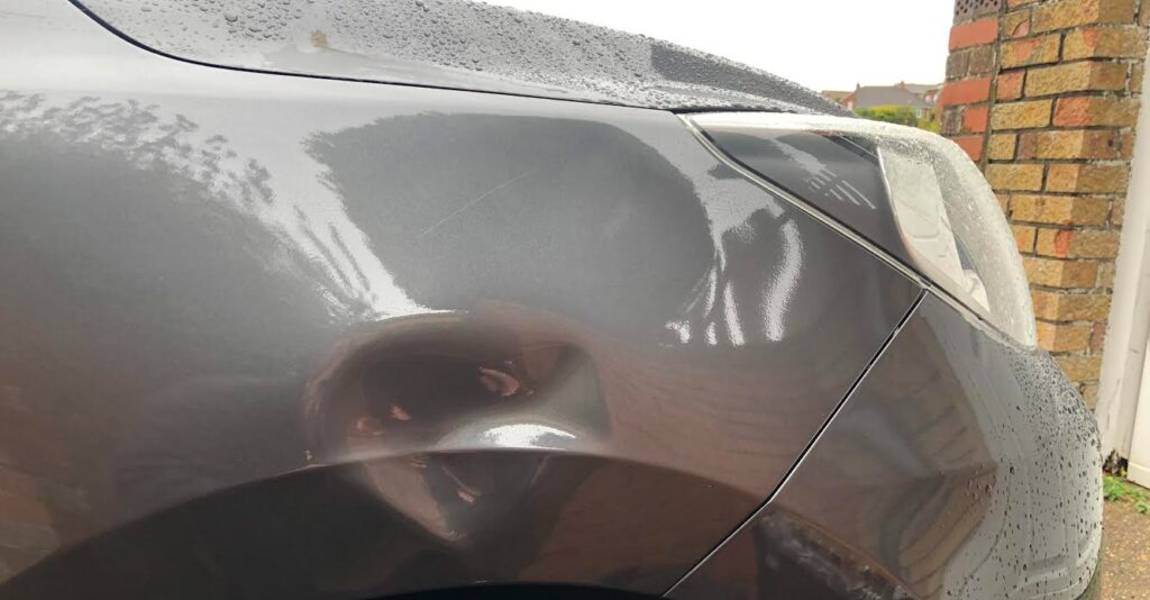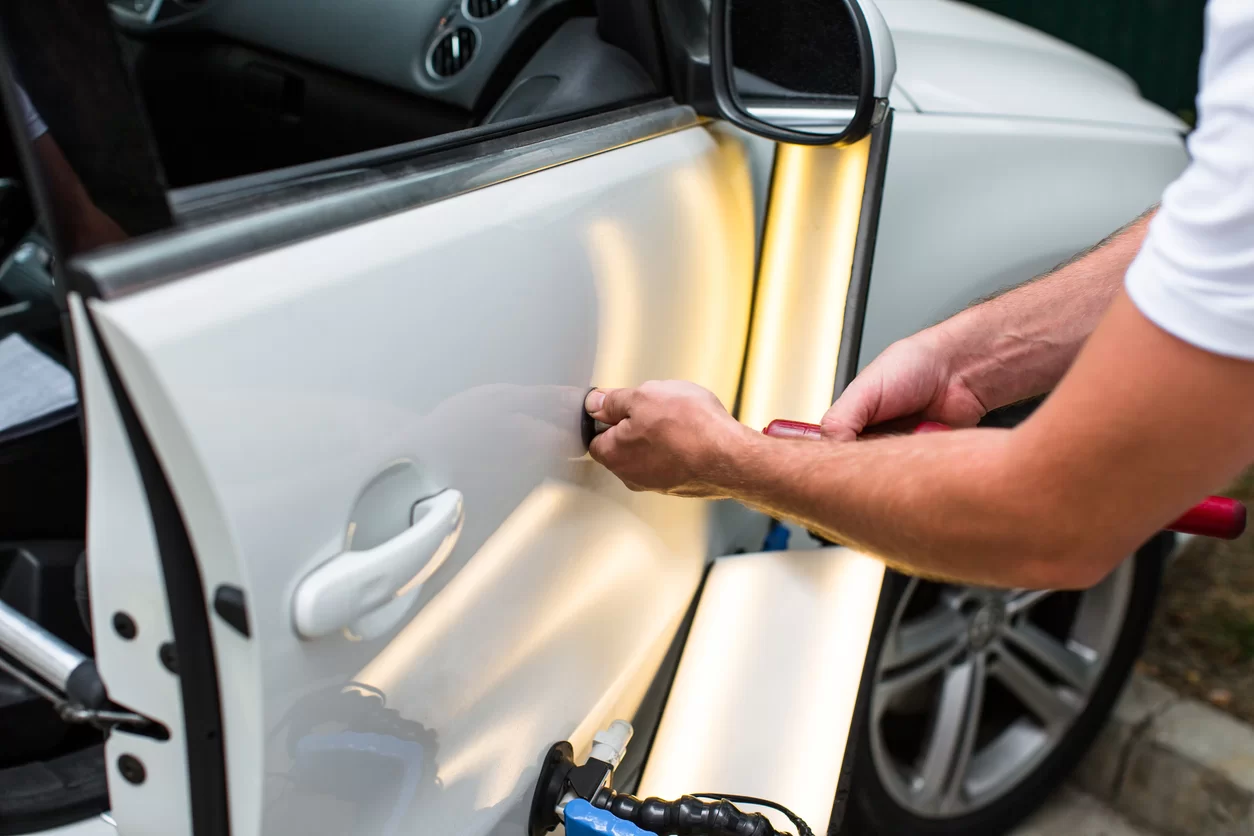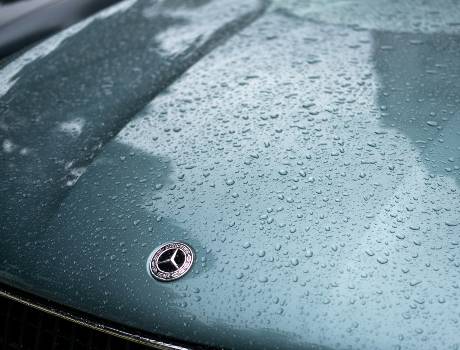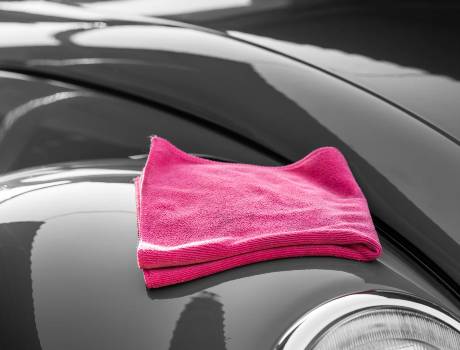Denver winter can be a challenging season for vehicle maintenance, with cold temperatures, snow, ice, and other weather conditions causing wear and tear. But when it comes to Paintless Dent Repair (PDR), winter may actually be the best time to get those dings and dents fixed. Here are eight compelling reasons why Winter is Ideal for Paintless Dent Repair (PDR), preserving your car’s appearance and long-term value.

Table of Contents
Understanding Paintless Dent Repair (PDR)
What is Paintless Dent Repair?
Paintless Dent Repair, or PDR, is a specialized technique for removing minor dents from a car’s body without repainting or refinishing. This method preserves the vehicle’s original paint and allows for faster, cost-effective dent removal. With PDR, skilled technicians use specialized tools to massage the metal back into shape without damaging the paint.
How Does PDR Work?
PDR involves a highly trained technician applying precise pressure and specialized tools to gently massage dents out of the vehicle’s panels. This technique requires skill and experience, as even a slight miscalculation can result in unsightly waves or creases.
Benefits of Choosing PDR Over Traditional Dent Repair
Opting for PDR has many advantages, including lower costs, shorter repair times, and the preservation of the original factory paint. Additionally, PDR helps maintain the vehicle’s resale value since it doesn’t require aftermarket paint or fillers.
Why Consider PDR in Winter?
Winter is Ideal for Paintless Dent Repair. Consider paintless dent repair (PDR) in winter to keep your vehicle looking its best and prevent minor dents from worsening. Winter weather conditions, such as snow and ice, can make dents more susceptible to rust and corrosion, potentially leading to costly repairs down the road. PDR is a quick, effective solution to maintain your car’s appearance and protect it against further winter damage.
Choose The Best PDR Shop for Winter Dent Repair
The best PDR, Paintless Dent Repair shop for winter dent repair offers expert services to quickly and effectively restore your vehicle’s appearance after winter storms and icy conditions. With skilled technicians and state-of-the-art tools, they ensure high-quality results without compromising your car’s original paint finish.
Winter’s Impact on Car Exteriors
Denver winter weather poses unique challenges to a vehicle’s exterior. Snow, ice, road salt, and debris can all cause minor dents or exacerbate existing damage. Additionally, winter light conditions often make these imperfections more visible, which can drive car owners to seek repairs. Winter is Ideal for Paintless Dent Repair work.
Unique Advantages of PDR During Colder Months
The PDR process works exceptionally well in cold weather, as low humidity improves the stability and adhesion required for a smooth repair. Unlike traditional repair, which may take longer in cold weather due to paint drying times, PDR is faster and unaffected by these conditions. Winter is Ideal for Paintless Dent Repair work.
Common Causes of Winter Dents and Dings
In winter, common causes of minor dents include hailstorms, slipping on icy roads, and minor accidents. Additionally, frozen debris on roads can contribute to dents and scratches that make PDR a practical solution. Check out our guide, Tips for Preventing Winter-Related Dents and Dings.
Reason 1: Winter Weather Can Reveal Hidden Dents
Snow and Ice Highlighting Imperfections
Snow and ice can settle into minor indentations, making dents more noticeable. This is especially true when snow melts unevenly, highlighting even the smallest imperfections. Winter weather makes it easier to spot dents that may have gone unnoticed otherwise.
Lower Light Angles Bringing Out Dent Shadows
During winter, the angle of sunlight changes, often casting long shadows that reveal dents more clearly. This seasonal lighting makes it easier to identify areas where PDR can improve your car’s look.
Reason 2: Less Humidity Improves PDR Results
Reduced Moisture Leading to More Stable Repairs
Winter’s lower humidity helps prevent moisture buildup, which can interfere with adhesives or warp metal. The dry air provides optimal conditions for PDR, allowing technicians to achieve a seamless repair that holds up well over time.
Why Winter Air Quality Benefits PDR Adhesion
Lower humidity also means fewer contaminants in the air, making it easier to achieve a perfect finish. This air quality factor can be especially beneficial for maintaining a pristine repair that blends naturally with your car’s original paint.
Reason 3: Faster Appointments During Winter
Slower Season for Auto Repairs Means Shorter Wait Times
Winter is generally a quieter season for auto repairs, as many people avoid non-essential maintenance. This reduced demand translates to faster appointment availability and often quicker turnaround times, making winter an ideal time to schedule PDR.
Reduced Repair Demand During Holidays
With many people traveling or focusing on holiday plans, auto shops are less busy, allowing you to get in and out more efficiently. This downtime makes it easy to book a PDR appointment without the typical scheduling hassle.
Reason 4: Protect Your Car Before Spring
Importance of Repairing Winter Dents Before Salt and Debris Exposure
Winter brings exposure to road salt and debris, which can worsen existing dents. If left untreated, these dents can develop rust or corrosion. Fixing them now protects your vehicle from potential long-term damage.

Preparing Your Car for Spring and Summer with a Smooth Finish
Addressing dents in winter ensures your car looks its best for spring and summer. A smooth, dent-free exterior not only looks better but also provides a layer of protection against seasonal weather elements.
Reason 5: Winter Conditions Cause Frequent Minor Dents
Effects of Hail, Ice, and Snow on Vehicle Panels
Winter weather frequently causes minor dents due to hail, ice accumulation, or compact snow on the roads. These small imperfections are ideal candidates for PDR, as they’re typically not deep or paint-damaging.
Why Minor Winter Dents Are Ideal for PDR
PDR works best on shallow dents that haven’t cracked the paint. Winter dents tend to fit these criteria, making the cold season an ideal time for effective PDR treatment without needing a full paint job.
Reason 6: PDR Helps Protect Against Further Damage
Preventing Rust and Corrosion by Fixing Dents Early
Leaving dents untreated during winter can lead to rust formation as moisture seeps into the metal. By getting PDR, you can prevent rust from forming, helping to extend your car’s lifespan and maintain its aesthetics.
The Role of PDR in Preserving Car Paint in Winter
PDR is a paint-preserving repair method, keeping your vehicle’s original finish intact. In winter, this advantage helps protect your car from the harsh elements without the need for paint or filler, maintaining the vehicle’s factory look.
Reason 7: Winter PDR Enhances Vehicle Resale Value
Ensuring Car Aesthetics Remain Sharp During Winter
Keeping your car’s exterior in great shape during winter boosts its resale value. A vehicle with fewer visible dents and a well-maintained exterior will appeal more to potential buyers.
How PDR Supports Long-Term Vehicle Value Preservation
PDR is a value-preserving repair option that keeps the original paint intact. It’s a smart choice for anyone planning to sell or trade in their vehicle in the future, as it ensures long-term cosmetic appeal.
Reason 8: PDR Keeps Your Car Looking New All Year Round
Embracing PDR for a Year-Round Pristine Look
With regular PDR, your car maintains its pristine look all year round, regardless of winter’s effects. This preventive maintenance is key to keeping your vehicle looking newer for longer.
How Winter Dent Repair Contributes to a Clean Car Aesthetic
By addressing dents promptly, especially during winter, PDR helps keep your car clean and well-maintained. It’s an investment in both appearance and protection, giving you peace of mind on the road.
Frequently Asked Questions (FAQs) Why Winter is Ideal for Paintless Dent Repair
What makes winter an ideal time for PDR?
Winter is Ideal for Paintless Dent Repair due to reduced humidity, quicker appointments, and lower repair demand, all contributing to optimal PDR results.
Can cold weather affect the PDR process?
No, PDR can be done effectively in cold weather, especially since it doesn’t require paint or fillers that could be affected by cold.
How does PDR compare to traditional repair in winter?
PDR is quicker and more cost-effective, as it doesn’t involve repainting, which can be affected by winter temperatures.
Will PDR remove all types of dents, even those from winter conditions?
PDR is best for shallow dents without paint damage. Most winter dents fit this description, making them ideal for PDR.
Is winter PDR more affordable?
Prices for PDR typically remain consistent year-round, though winter’s lower demand can sometimes lead to faster and potentially discounted services.
Can PDR help prevent rust and corrosion?
Yes, by fixing dents promptly, PDR prevents moisture from getting trapped and causing rust.
Conclusion – Winter is Ideal for Paintless Dent Repair
Winter is a prime time for Paintless Dent Repair (PDR) due to ideal atmospheric conditions, faster scheduling, and the advantage of preventing rust or corrosion. Investing in PDR during winter ensures that your car remains in top shape, protected from the elements and ready for a smooth, damage-free look come spring.








WHAT OUR CLIENTS ARE SAYING